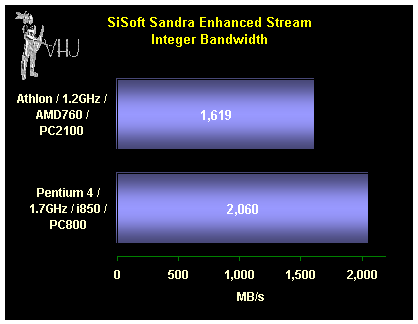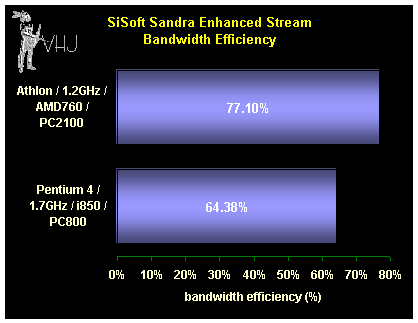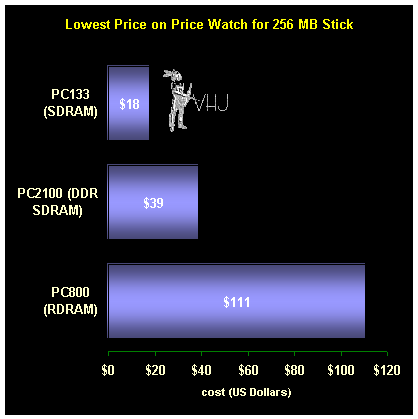
Benchmark Shows DDR SDRAM More Bandwidth Efficient Than RDRAM
By Van Smith
Date: July 20, 2001
A new version of a popular independent benchmark shows that DDR SDRAM may be considerably more efficient when transferring data to the CPU than RDRAM.

British company SiSoftware recently enhanced its widely used Sandra utility suite to include processor specific data streaming optimizations in the utility's bandwidth benchmarks. Bandwidth is the rate of flow of data, usually expressed in megabytes per second or gigabytes per second. In a note passed to beta testers, Adrian Silasi, CTO of SiSoftware stated:
This minor beta marks one of the most important changes in the benchmarks so far; it is time to replace the ALU/FPU STREAM tests that have been around since the first release way back in 1997 with modern equivalents that take advantage of the EMMX/SSE/SSE2 streaming/prefetching instructions in order to show the real bandwidth of the current platforms.
While there have been SSE2 STREAM versions in Sandra for the P4 since Sandra 2001, these were disabled as there was no equivalent for the PIII/Athlon/Duron. With AMD, SGI and other entities/interested people help we have developed a common version that supports all common platforms, i.e. PIII/P4/Athlon/Duron/VIA C3.
Briefly (http://www.sgi.com/developers/library/resources/asc_cpu.html), the new tests work by streaming the data into the L1 cache while working on the previous data and posting the results directly to memory without "polluting" the caches. This way the true limit of useable memory bandwidth is approached.
The idea is that these benchmarks will be enabled by default on modern CPUs. Of course, the ALU/MMX/FPU tests will remain and will be used on older processors, e.g. PII, old Celeron, K6, Pentium, etc. The user will be able to disable these new tests if it so wishes as before.
We ran this program on competing platforms from AMD and Intel, with both systems equipped with 512MB of RAM. The Intel Pentium 4 system used PC800 Rambus RDRAM, while the AMD platform used PC2100 DDR SDRAM. Tests were run under Windows ME with Sandra beta version 2001.6.8.15 (sb815mb1). As one should by now expect, the Pentium 4 provides higher bandwidth as can be seen below.

However, what is important to notice is that using the new, enhanced version of the Sandra bandwidth benchmark yields more than a 100% increase in performance for the Athlon / DDR SDRAM combo but less than a 50% gain for the Pentium 4. Using the older version of Sandra, the reference scores for the Intel / PC800 RDRAM platform was 1,374 MB/s, while the AMD760 / PC2100 DDR SDRAM system is only 652 MB/s.
The reason why the DDR SDRAM platform performed so poorly on the older version of Sandra was due to architectural differences between the Athlon and the Pentium 4. To put this statement in better perspective, the Pentium 4 has many architectural tweaks to deliver maximum bandwidth, but sometimes has to pay for these measures. A few differences are explained in our recent nForce article.
Unfortunately, some in the media have tried to compare DDR SDRAM and Rambus RDRAM performance without considering these innate processor architectural differences (on an equally sad note, some in the media like ExtremeTech have uncritically reported bandwidth for the Pentium 4 that is physically impossibile -- older versions of Sandra had a well known bug that resulted in SSE2 enhanced FPU bandwidth tests to be off by a factor of two and well beyond the 3.2 GB/s physical limits of the platform).
A caveat can still be made with the SiSoftware test, but the new version of Sandra represents the first attempt by a professional benchmark developer to wring maximum bandwidth performance from both DRAM platforms.
The graph below shows relative platform efficiencies in delivering maximum practical bandwidth. The numbers were obtained by dividing the bandwidth in the graph above with the theoretical bandwidth maximum for both platforms. The Intel / Rambus platform has a theoretical maximum of 3,200 MB/s, while 2,100 MB/s is the limit for the Athlon / DDR SDRAM platform.

As can be seen, the Athlon / DDR SDRAM system comes far closer to reaching its theoretical bandwidth maximum than the Intel / Rambus combination.
Note that Intel / Rambus memory performance degrades when more memory is added to the system. This performance degradation is due to additional channel latencies inherent to the serial nature of RDRAM. Also, Pentium 4 benchmarks sometimes run significantly better on Windows 2000. To gauge this variability, the tests were repeated on the same Intel / Rambus system using only half the memory and running Windows 2000. The results, 2,162 MB/s, still left the DDR / Athlon / Windows ME system well ahead in terms of bandwidth efficiency.
Again, these conclusions are based upon optimizations of just one company on a single benchmark. Nevertheless the results are compelling and represent the best opportunity yet to compare the relative merits of the two memory technologies on somewhat equal footing. Of course, the best situation would be to use the same CPU with RDRAM and DDR SDRAM chipsets possessing similar qualifications. Unfortunately, we will likely have to wait until Intel delivers DDR SDRAM i845 parts so that a fair comparison can be made with the i850.
At this point, it is probably safe to assume that a dual channel DDR SDRAM chipset similar to nForce would elevate effective P4 bandwidth beyond what the dual channel RDRAM i850 can offer.
More Dubious RDRAM Claims
A recent Intel document attempts to debunk "myths" involving RDRAM. One of the claims made in the white paper is as follows (it is interesting to compare Intel's "myth" below with what we wrote well over a year ago):
Myth: RDRAM is expensive and will always be more expensive than SDRAM or DDR.
Reality: RDRAM prices are rapidly falling. From Q2 ’00 to Q2 ’01, the price for a 128 MB RIMM (non-ECC) has come down over 65%. As volumes ramp, 4i technology is introduced, and memory densities continue to increase, RDRAM costs will continue to decline. In 2002, market projections are that RDRAM costs to memory manufactures will be within 5% of PC133.
While this statement accurately reflects the downward trend on Rambus RDRAM prices, it fails to point out the equally important fact that both DDR SDRAM and SDRAM prices have decreased in almost equal measure as well. The following graph is based upon the latest data we could obtain from the shopping engine Price Watch.

The graph indicates clearly that far from reaching price parity, Rambus RDRAM is currently selling for 620% of the price currently being asked for SDRAM. This price ratio has not changed substantially since when we first reported on this subject well over a year ago. Moreover, the cost of a 256MB RDRAM RIMM is a whopping 2.8 times the price of a comparable PC2100 DDR SDRAM DIMM.
On top of this, PC2100 DDR SDRAM delivers over 30% greater bandwidth than PC800 RDRAM (the Intel Pentium 4 / i850 combo offers 3.2 GB/s by combining two RDRAM channels, similar to how the upcoming DDR SDRAM powered nForce achieves 4.2 GB/s -- however, in both cases this means that memory must be added in pairs to achieve maximum bandwidth). Additionally, DDR SDRAM has been out for only about 1/3 as long as RDRAM, indicating that the ramp for DDR is progressing much more favorably.
Unfortunately, it is evident that the dubious marketing claims associated with the Intel / Rambus duo continue from last year. Why Santa Clara CPU manufacturer chooses to prolong a campaign that has cost it so much face is puzzling.
What Fate Rambus?
The fate of Rambus took a swing upwards with Intel's use of RDRAM with it's flagship processor. However, the Pentium 4 has not met with great market success, and the Santa Clara chipmaker will soon be releasing an SDRAM based chipset, the i845 (Brookdale), followed in a few months by much faster DDR SDRAM powered Brookdale solutions.
Availability of DDR SDRAM Pentium 4 chipsets will likely marginalize RDRAM quickly, but what is more ominous to the long term viability of RDRAM is talk that Intel is closely involved in writing the DDR III specification. In fact, the Intel founded Advanced DRAM Technology (ADT) initiative is allegedly rolling in its technology with DDR III. ADT, a group Intel has pointedly excluded Rambus from, is believed to be involved in designing a low pin-count, high bandwidth, next generation memory technology as a direct alternative to Rambus RDRAM.
Combined with the Mountain View, California memory designer's devastating recent court setbacks, the outlook for Rambus itself is gloomier than ever. Even the company's long term prospects in the embedded market, where its low pin-count designs make sense, are potentially threatened by ADT and DDR III.
RDRAM's inability to match DDR SDRAM's bandwidth efficiency in SiSoftware's new Sandra only underscores one reason why this company's fate has taken such a cataclysmic slide downwards.
===================================
===================================